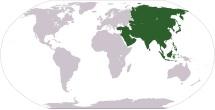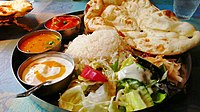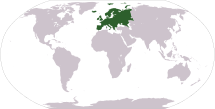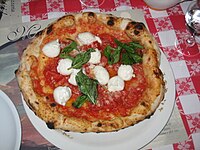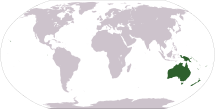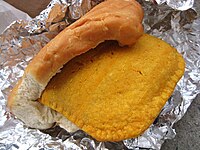Cuisine/ja: Difference between revisions
Created page with "== 歴史{{Anchor|History}} == {{Further/ja|List of historical cuisines/ja}} 料理は古典古代にまで遡る。食事がより計画的になるにつれて、文化を中心とした食事が登場するようになった。" Tags: Mobile edit Mobile web edit |
Created page with "==参考資料== * Albala, Ken (2011). [https://books.google.com/books?id=zG1H75z0EYYC ''Food Cultures of the World Encyclopedia''] Greenwood. {{ISBN|978-0-313-37626-9}}. * California Culinary Academy (2001). ''In the World Kitchen: Global Cuisine from California Culinary Academy''. Bay Books (CA). {{ISBN|1-57959-506-5}}. * Laudan, Rachel (2013). [https://books.google.com/books?id=kaDTAAAAQBAJ ''Cuisine and Empire: Cooking in World History''] University of California Pre..." Tags: Mobile edit Mobile web edit |
||
| Line 169: | Line 169: | ||
</div> | </div> | ||
==参考資料== | |||
* Albala, Ken (2011). [https://books.google.com/books?id=zG1H75z0EYYC ''Food Cultures of the World Encyclopedia''] Greenwood. {{ISBN|978-0-313-37626-9}}. | * Albala, Ken (2011). [https://books.google.com/books?id=zG1H75z0EYYC ''Food Cultures of the World Encyclopedia''] Greenwood. {{ISBN|978-0-313-37626-9}}. | ||
* California Culinary Academy (2001). ''In the World Kitchen: Global Cuisine from California Culinary Academy''. Bay Books (CA). {{ISBN|1-57959-506-5}}. | * California Culinary Academy (2001). ''In the World Kitchen: Global Cuisine from California Culinary Academy''. Bay Books (CA). {{ISBN|1-57959-506-5}}. | ||
| Line 178: | Line 177: | ||
* Scarparto, Rosario (2000). [https://books.google.com/books?id=lthfNAAACAAJ ''New global cuisine: the perspective of postmodern gastronomy studies''.] Royal Melbourne Institute of Technology. | * Scarparto, Rosario (2000). [https://books.google.com/books?id=lthfNAAACAAJ ''New global cuisine: the perspective of postmodern gastronomy studies''.] Royal Melbourne Institute of Technology. | ||
* Zobel, Myron (1962). [https://books.google.com/books?id=_TqlGAAACAAJ ''Global cuisine: being the unique recipes of the 84 top restaurants of the world'']. Patron Press. | * Zobel, Myron (1962). [https://books.google.com/books?id=_TqlGAAACAAJ ''Global cuisine: being the unique recipes of the 84 top restaurants of the world'']. Patron Press. | ||
==外部リンク== | ==外部リンク== | ||
Revision as of 13:15, 25 May 2025

料理とは、独特の食材、調理法、ディッシュによって特徴づけられる調理のスタイルであり、通常、特定の文化や地理的地域と関連付けられる。地域の食品調理技術、習慣、食材が組み合わさることで、その地域独自の料理が生まれる。
語源
「Cuisine」という言葉は、18世紀後半から英語で使われ始めた。これは「調理の方法や様式」を意味し、フランス語の「料理のスタイル」(文字通りには「台所」)から借用されたもので、元々はラテン語の「coquere
料理への影響
料理は、その地域で入手可能な食材、または貿易を通じて入手可能な食材によって部分的に決定される。地域特有の食材は開発され、日本料理における日本米のように、地域または国の料理に一般的に貢献する。
宗教的な食物法も料理に影響を与える場合があり、インド料理やヒンドゥー教は、神聖な動物崇拝のため主にラクトベジタリアン(肉と卵を避ける)である。パンジャブ料理におけるシク教、東アジア料理における仏教菜食主義、ヨーロッパ料理におけるキリスト教の食事法、中東料理におけるイスラムの食事法、ユダヤ料理およびイスラエル料理におけるカシュルートはすべて、料理に影響を与えている。
ある地域の料理に影響を与える要因としては、その地域の気候、異なる国々間の貿易、宗教的または奢侈禁止法、料理文化の交流などがある。例えば、熱帯地域の食事は果物や野菜により重きを置くかもしれないが、極地の食事は肉や魚に依存する傾向があるかもしれない。
その地域の気候は、利用可能な固有の食品を大いに決定する。加えて、気候は食品の保存に影響を与える。例えば、冬の消費のために燻製、塩漬け、ピクルスによって保存された食品は、その変化した味覚特性のために世界の料理において重要なままである。
異なる国々間の貿易もまた、地域の料理に大きく影響する。古代の香辛料貿易にまでさかのぼると、シナモン、カシア、カルダモン、ショウガ、ウコンなどの調味料は、貿易の最も初期の発展において重要な商品であり、インドはこのための国際市場であった。シナモンとカシアは少なくとも4000年前に中東に伝わった。
特定の食品や食品調理は、イスラムの食事法やユダヤの食事法のように、宗教性や奢侈禁止法によって要求されたり禁止されたりする。
料理文化の交流も多くの地域の料理にとって重要な要因である。日本が初めて本格的かつ直接的に西洋に触れたのは、16世紀後半にヨーロッパの宣教師が到着した時であった。当時、スペインとポルトガルの肉の揚げ物技術と、東アジアの油で野菜を調理する方法が組み合わさって、「魚介類や様々な種類の野菜に衣をつけて揚げた人気の日本料理」である天ぷらが発展した。
歴史
料理は古典古代にまで遡る。食事がより計画的になるにつれて、文化を中心とした食事が登場するようになった。
Evolution of cuisine

Cuisines evolve continually, and new cuisines are created by innovation and cultural interaction. One recent example is fusion cuisine, which combines elements of various culinary traditions while not being categorized per any one cuisine style, and generally refers to the innovations in many contemporary restaurant cuisines since the 1970s. Nouvelle cuisine ('New cuisine') is an approach to cooking and food presentation in French cuisine that was popularized in the 1960s by the food critics Henri Gault, who invented the phrase, and his colleagues André Gayot and Christian Millau in a new restaurant guide, the Gault-Millau, or Le Nouveau Guide. Molecular cuisine, is a modern style of cooking which takes advantage of many technical innovations from the scientific disciplines (molecular cooking). The term was coined in 1999 by the French INRA chemist Hervé This because he wanted to distinguish it from the name Molecular gastronomy (a scientific activity) that was introduced by him and the late Oxford physicist Nicholas Kurti in 1988. It is also named as multi sensory cooking, modernist cuisine, culinary physics and experimental cuisine by some chefs. Besides, international trade brings new foodstuffs including ingredients to existing cuisines and leads to changes. The introduction of hot pepper to China from South America around the end of the 17th century, greatly influencing Sichuan cuisine, which combines the original taste (with use of Sichuan pepper) with the taste of newly introduced hot pepper and creates a unique mala (麻辣) flavor that's mouth-numbingly spicy and pungent.
Global cuisine
A global cuisine is a cuisine that is practiced around the world, and can be categorized according to the common use of major foodstuffs, including grains, produce and cooking fats.
Regional diversity
Regional cuisines can vary based on availability and usage of specific ingredients, local cooking traditions and practices, as well as overall cultural differences. Such factors can be more-or-less uniform across wide swaths of territory, or vary intensely within individual regions. For example, in Central and North South America, corn (maize), both fresh and dried, is a staple food, and is used in many different ways. In northern Europe, wheat, rye and fats of animal origin predominate, while in southern Europe olive oil is ubiquitous and rice is more prevalent. In Italy, the cuisine of the north, featuring butter and rice, stands in contrast to that of the south, with its wheat pasta and olive oil. In some parts of Greece, gyros is the staple, while in others this role is filled by bread. Throughout the Middle East and Mediterranean, common ingredients include lamb, olive oil, lemons, peppers and rice. The vegetarianism practiced in much of India has made pulses (crops harvested solely for the dry seed) such as chickpeas and lentils as important as wheat or rice. From India to Indonesia, the extensive use of spices is characteristic; coconuts and seafood are also used throughout the region both as foodstuffs and as seasonings.
African cuisines use a combination of locally available fruits, cereals and vegetables, as well as milk and meat products. In some parts of the continent, the traditional diet features a preponderance of milk, curd and whey products. In much of tropical Africa, however, cow's milk is rare and cannot be produced locally (owing to various diseases that affect livestock). The continent's diverse demographic makeup is reflected in the many different eating and drinking habits, dishes and preparation techniques of its manifold populations.
-
Spices at central market in Agadir, Morocco
Due to Asia's vast size and extremely diverse geography and demographics, Asian cuisines are many and varied, and include East Asian cuisine, South Asian cuisine, Southeast Asian cuisine, Central Asian cuisine and West Asian cuisine. Ingredients common to East Asia and Southeast Asia (due to overseas Chinese influence) include rice, ginger, garlic, sesame seeds, chilies, dried onions, soy and tofu, with stir frying, steaming and deep frying being common cooking methods. While rice is common to most regional cuisines in Asia, different varieties are popular in the different regions: Basmati rice is popular in South Asia, Jasmine rice in Southeast Asia, and long-grain rice in China and short-grain rice in Japan and Korea. Curry is also a common ingredient found in South Asia, Southeast Asia and East Asia (notably Japanese curry); however, they are not popular in West Asian and Central Asian cuisines. Those curry dishes with origins in South Asia usually have a yogurt base, with origins in Southeast Asia a coconut milk base, and in East Asia a stewed meat and vegetable base. South Asian cuisine and Southeast Asian cuisine are often characterized by their extensive use of spices and herbs native to the tropical regions of Asia.
-
Due to Guangdong's location on the southern coast of China, fresh live seafood is a specialty in Cantonese cuisine. Such markets selling seafood are found across East Asia.
-
Traditional North Indian vegetarian thali with various curries from India. Various curry dishes are found across South Asia.
-
A market stall at Thanin market in Chiang Mai, Thailand, selling readily-made food. Market stalls selling food are found across Southeast Asia.
-
A Tajik feast. A large feast is commonly associated with cultures of Central Asia.
-
Typical Assyrian cuisine; an example of a type of meal found in West Asia
European cuisine (alternatively, "Western cuisine") include the cuisines of Europe and other Western countries. European cuisine includes non-indigenous cuisines of North America, Australasia, Oceania and Latin America as well. The term is used by East Asians to contrast with East Asian styles of cooking. When used in English, the term may refer more specifically to cuisine in (Continental) Europe; in this context, a synonym is Continental cuisine.
-
German sausages and cheese
-
Beef Stroganoff, a Russian dish
Oceanian cuisines include Australian cuisine, New Zealand cuisine and cuisines from many other islands or island groups throughout Oceania. Australian cuisine consists of immigrant Anglo-Celtic derived cuisine, and Bushfood prepared and eaten by native Aboriginal Australian peoples, and various newer Asian influences. New Zealand cuisine also consists of European inspired dishes, such as Pavlova, and native Māori cuisine. Across Oceania, staples include the Kūmura and Taro, which was/is a staple from Papua New Guinea to the South Pacific. On most islands in the south pacific, fish are widely consumed because of the proximity to the ocean.
-
Bush Tucker (bush foods) harvested at Alice Springs Desert Park in Australia
-
A Hāngī being prepared, a New Zealand Māori method of cooking food for special occasions using hot rocks buried in a pit oven
-
Samoan umu, an oven of hot rocks above ground
The cuisines of the Americas are found across North and South America, and are based on the cuisines of the countries from which the immigrant people came from, primarily Europe. However, the traditional European cuisine has been adapted by the addition of many local and native ingredients, and many of their techniques have been added to traditional foods as well. Native American cuisine is prepared by indigenous populations across the continent, and its influences can be seen on multi-ethnic Latin American cuisine. Many staple foods have been seen to be eaten across the continent, such as corn (maize), beans and potatoes have their own respective native origins. The regional cuisines are North American cuisine, Mexican cuisine, Central American cuisine, South American cuisine and Caribbean cuisine.
-
Bandeja paisa from Peñól de Guatapé in Antioquia, Colombia
-
A Jamaican patty wrapped in coco bread
-
Buffalo wings with blue cheese dressing, served with lager beer
See also
参考資料
- Albala, Ken (2011). Food Cultures of the World Encyclopedia Greenwood. ISBN 978-0-313-37626-9.
- California Culinary Academy (2001). In the World Kitchen: Global Cuisine from California Culinary Academy. Bay Books (CA). ISBN 1-57959-506-5.
- Laudan, Rachel (2013). Cuisine and Empire: Cooking in World History University of California Press. ISBN 978-0-520-26645-2.
- MacVeigh, Jeremy (2008). International Cuisine. Delmar Cengage Learning; 1st edition. ISBN 1-4180-4965-4.
- Nenes, Michael F; Robbins, Joe (2008). International Cuisine. Hoboken, N.J.: Wiley, John & Sons; 1st edition. ISBN 0-470-05240-6.
- Scarparto, Rosario (2000). New global cuisine: the perspective of postmodern gastronomy studies. Royal Melbourne Institute of Technology.
- Zobel, Myron (1962). Global cuisine: being the unique recipes of the 84 top restaurants of the world. Patron Press.
外部リンク
 Eating and drinking travel guide from Wikivoyage
Eating and drinking travel guide from Wikivoyage- The Elizabeth Robins Pennell Collection がアメリカ議会図書館にあり、料理に関する多くの書物を所蔵している。
| この記事は、クリエイティブ・コモンズ・表示・継承ライセンス3.0のもとで公表されたウィキペディアの項目Cuisine(7 May 2025, at 03:30編集記事参照)を翻訳して二次利用しています。 |





